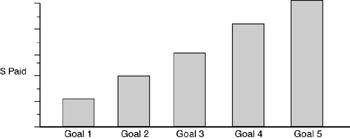Financial Incentives For Retaining Talent during A Crisis
The most straightforward way to create incentives for people to stay during a crisis is to make their tenure with the company “profitable.” There are financial and nonfinancial elements to these incentives. In this section we describe financial incentives, and in Chapter 10 we will go into detail concerning the nonfinancial incentives that are relevant in a crisis.
Financial incentives generally translate into a cash incentive plan. For a short-term situation, cash is a critical vehicle to motivate people to stay. The incentive should also directly tie to important results for the company and align everyone’s interests in working toward results. This fourth step in motivating people to stay during a crisis is a capstone on executing the first three steps: A capable and credible leadership team must be assembled and everyone’s motivations must be understood and then aligned with a simple, straightforward plan. An incentive will reinforce and support the plan. Putting together an incentive plan involves the following:
-
Start with three or four simple goals for everyone to work on to get the company on a path to recovery.
-
Make the time period short enough to capture everyone’s attention, which might be anywhere from 6 to 12 months.
-
Focus on operations or activities that people can actually do that will result directly in the expected changes.
-
Have a set of goals that “roll up” from the lowest level of daily operations to the top level of management. This will get everyone working toward the same ultimate goal. This means that employees working in a plant or production facility will be working on the same plan as senior executives.
-
Provide meaningful financial results for reaching the goal, such as a cash award starting at 5 to 10 percent of each employee’s salary for reaching goals and going upward for exceptional results.
Borden Foods followed these five steps in developing its incentive plan during the crisis described earlier. The first step Borden took was to identify a specific set of “challenge” goals that the entire company could embrace. The most important goal for the organization was to raise the level of profit or earnings before interest expenses and taxes (EBIT) were paid. Earnings were computed as sales minus costs of operating the business. This was senior leadership’s key responsibility. While everyone in the company in some way contributed to profit, the concept of EBIT was really too abstract for a direct and immediate impact on all employees. Recognizing this, senior leadership determined that the greatest number of employees had an impact on the conversion and distribution costs of the company, whether they worked in a plant, a warehouse, or in the customer service department. Conversion costs included the costs of converting raw ingredients and packaging materials into finished products, not including the actual purchase price of raw materials. Distribution costs included the costs incurred to deliver products to customers and storage. Therefore, specific targets for conversion and distribution costs were set as challenge goals. In addition, the goals for conversion and distribution costs were to be met without a sacrifice in customer service levels.
Looking over the employee population, three groups were established to receive incentives. The first group was the senior leadership of the company. The second group was the professional and technical staff that included marketing and sales, customer service, research and development, human resources, administration, and other support staff. The third and last group included the majority of the employees, those involved in production and distribution facilities throughout North America.
The challenge goals for the plan were allocated differently for each group of employees as outlined in Table 3-2. All of the incentive for senior leadership was based on reaching the EBIT goal. Similarly, 100 percent of the operating employee incentive was based on operations and distribution cost goals. These goals were expressed as the cost per pound of converting raw material into product and the cost of shipping the product to customers. Operations employees had a clear and straightforward input on reaching this goal. Support employees’ goals were split evenly between conversion and distribution costs and EBIT. The support staff had an indirect impact on operations and also had an indirect impact on EBIT through their activities. Thus, their goals were split 50/50.
| Operations: | Support Staff: | Senior Leadership: | ||
|---|---|---|---|---|
| Employee Group | Production facilities Distribution facilities | Plant management Sales Support areas | Executive Company management | |
| Incentive Allocation | 100% | 50% | 50% | 100% |
| Performance Measure | Conversion and distribution costs | Conversion and distribution costs | EBIT | EBIT |
The time period for this incentive plan was one calendar year. To have impact it would take a number of months to establish initiatives to reduce costs and increase profits. At the same time senior leadership recognized that operations and distribution employees needed to receive feedback on reaching cost reduction goals in a more timely fashion. So the decision was made to have monthly measurements and payments on actually achieving the conversion and distribution costs goals. (See Figure 3-1). Interim payments were set for reaching interim objectives on the way to the year-end goal.

Figure 3-1: Incentive Payout Schedule
The payout for incentives was a meaningful part of total compensation for participating employees. The payout targets ranged from a minimum of 5 percent of base pay for entry-level employees to 40 percent of base pay for senior leadership.
The plan was very successful in capturing the attention of all employees and was a prominent part of the work life of the company. The company was quite successful in dropping operating costs and increasing profitability over the 12-month period and accomplished most of the goals.
EAN: 2147483647
Pages: 143